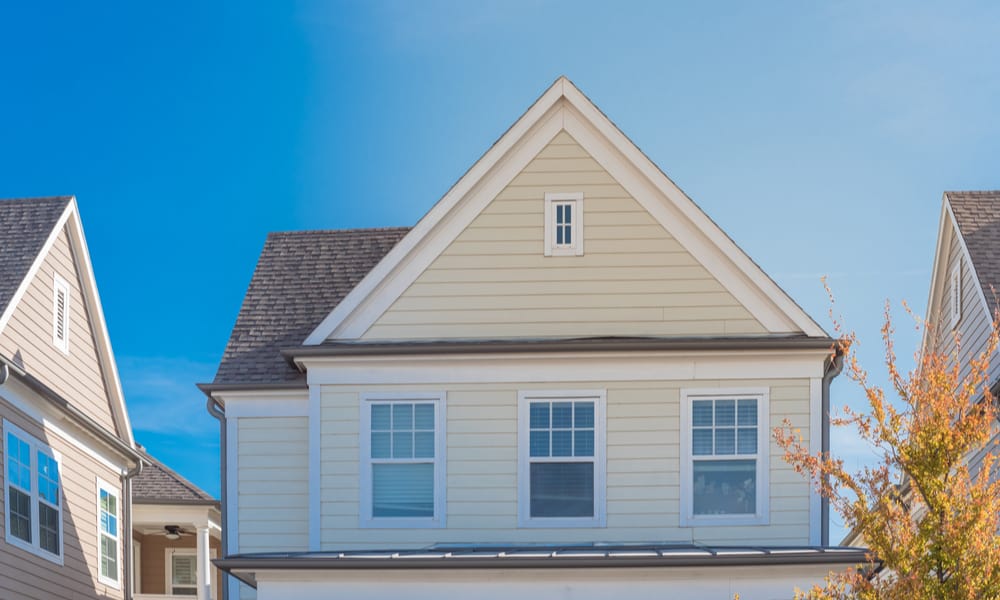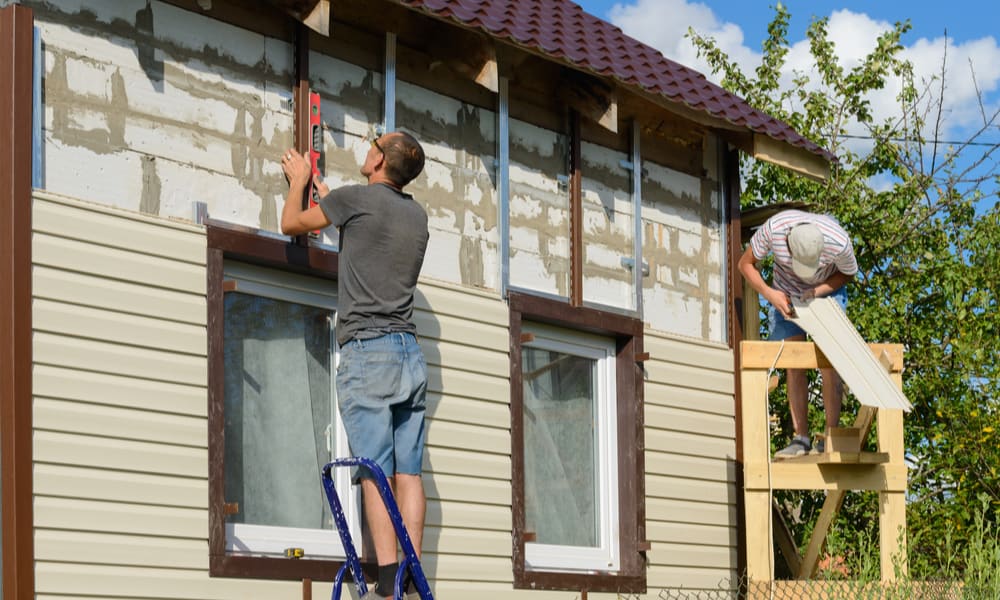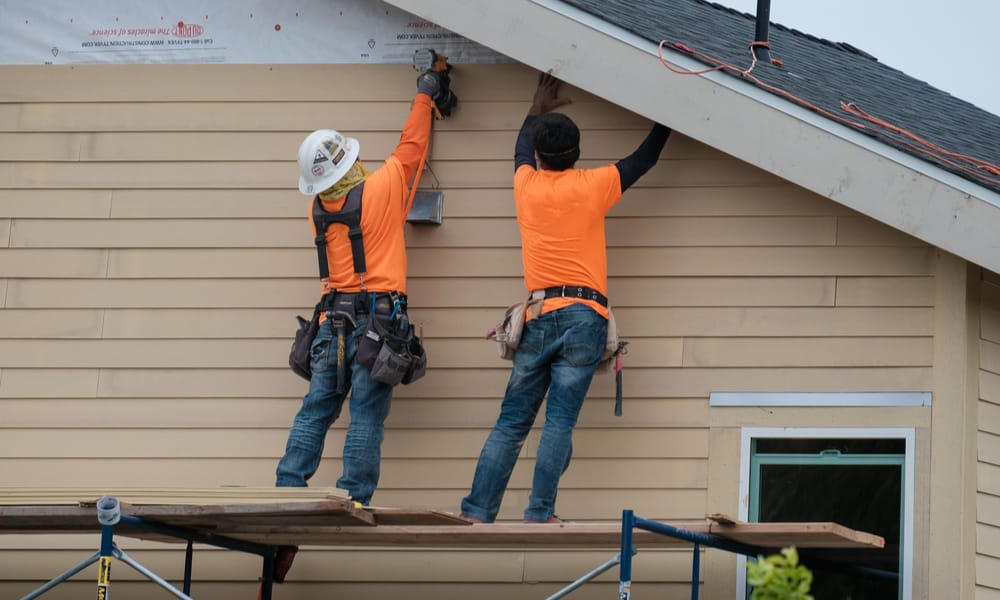The exterior walls are the face of your home, and an easy way to make them look sleek is with vinyl siding. For decades, traditional vinyl siding has been the go-to choice for homeowners and contractors alike. Now, you could opt for the insulated variant. But this is where you may wonder – insulated vinyl siding: is it worth the higher price tag? Let’s find it out.
Table of Contents
What Is Insulated Vinyl Siding?
Insulated vinyl siding looks just like standard vinyl siding, but it features a solid foam backing designed to insulate the house.
This type of siding consists of an outer layer made of polyvinyl chloride (PVC) backed by a layer of expanded polystyrene (EPS). The EPS is form-fitted to the outer PVC layer and then glued in place for a permanent connection.
Unlike standard vinyl siding, which has a stepped profile on both sides, insulated vinyl siding has a flat back that makes it easy to install flush against the wall. The insulation is relatively thin – about 1.25-inch thick at its thickest point – but the EPS’ thermal insulation abilities will add some R-value to your home.
How Is Insulated Vinyl Siding Different from Vinyl Siding?
The only difference between insulated vinyl siding and its standard counterpart is the EPS layer of the former. On the outside, insulated vinyl siding delivers a traditional “American home” look which is perfect if you’re a traditionalist at heart or if you don’t want to alter the aspect of a house you’re renovating. However, the backing adds some insulation while also driving up the siding’s cost.
With this in mind, let’s have a closer look at the advantages and drawbacks this type of siding comes with and see if it’s worth the investment.
Insulated Vinyl Siding Advantages
1. Improved aesthetics
There isn’t much difference between standard and insulated vinyl siding at first glance, but the latter actually looks better when installed.
The insulating foam adds structural support, helping the panels retain their shape. At the same time, the foam levels any wall imperfections. Overall, insulated vinyl siding helps raise the aesthetic value of your home.
2. Increased durability
Standard vinyl siding is designed to improve the looks of your home, but it isn’t very durable. Its stepped design on both sides leaves empty spaces between the back of the siding and the wall, which are vulnerable to damage.
This isn’t an issue with insulated vinyl siding. The back of the siding is installed flush against the wall and even allows you to use a major number of fasteners to secure it. Using more fasteners could be a great idea if you live in a harsher climate area, rendering the siding more resistant to extreme weather phenomena.
3. Noise-dampening abilities
Vinyl siding doesn’t provide noise insulation. However, insulated vinyl siding can dampen the noises coming from the outside. This feature is highly desirable, especially if you live in a busier neighborhood or near an airport or highway.
4. Keeps insects out
Besides increased durability and noise-dampening features, installing siding flushed against the wall comes with another important advantage – insects and other creepy crawlers will be left with no space to build their nests. Moreover, vinyl is an inorganic material, so it won’t be a target for termites either.
5. Higher energy efficiency
Another advantage of insulated vinyl siding is its higher energy efficiency. As we mentioned already, the EPS layer helps insulate your home, preventing heat loss in winter and keeping the interior cooler in summer. Thanks to this characteristic, insulated vinyl siding can help you save on utility bills.
6. Improved resale value
Ultimately, the greatest advantage of insulated vinyl siding is the improved resale value it gives your home. Not only will your exterior walls look good from an aesthetic standpoint, but it makes your home more energy-efficient and better insulated from noise.
Considering the number of colors you can find this type of siding, and its attractive, traditional look, investing in it is truly worth it.
Insulated Vinyl Siding Drawbacks
1. More expensive
The main disadvantage of insulated vinyl siding is the higher upfront cost compared to its standard counterpart. Not only do the panels cost more, but installing them is also more expensive.
2. Harder to install
As you can expect, insulated vinyl siding is thicker than hollow vinyl siding. Thus, installing it is more laborious. Although the installation process is more or less the same, you’ll have to use more tools and different fasteners.
Because of its thickness, this type of siding also requires more build-out around the doors and windows. All this additional work drives up the installation costs.
Vinyl Siding vs. Insulated Vinyl Siding
Knowing the insulated vinyl siding pros and cons is not always enough when trying to decide between one type of siding over the other. So, let’s break down the advantages – or lack thereof – insulated vinyl siding has over the traditional type.
- Cost: Starting with the wallet impact, insulated vinyl siding is more expensive than hollow vinyl siding. The standard type will cost you around $3.50 per square foot on average, whereas insulated vinyl siding can cost double that – around $7 per square foot, without considering installation costs. You can expect to pay up to $12 per square foot installed. However, insulated vinyl siding can help lower the cost of energy thanks to its insulating properties. Thus, even if it costs more upfront, it brings more benefits in the long run – especially if you live in a colder climate area.
- Durability: Vinyl siding doesn’t have the best reputation when it comes to durability, mostly because of the hollow void created between the siding and the wall. However, insulated vinyl siding goes flush against the wall when installed. This solves the durability issues, allowing you to enjoy it for a long time.
- Appearance: Overall, the insulated vinyl siding looks better than standard vinyl siding. It is also available in a wider number of colors and has a more refined appearance that emulates the looks of real wood.
- Energy saving: Any type of insulation helps reduce the costs of energy, but studies show that insulated vinyl siding can lower those costs by up to 14.5%. Not only that, but according to a study by the Federal Trade Commission, insulated vinyl siding has a higher environmental performance than siding made of cedar and other natural wood. Aside from monetary saving, insulated vinyl siding also improves the comfort level in your home.
- Resale value: Last but not least, insulated vinyl siding can drive up the resale value of your home. Not only will you get more money when selling your property, but according to Remodeling Magazine, you are more likely to recoup an investment made in siding compared to new roofing or a kitchen remodel.
Is It Worth the Extra Cost?
Whether or not insulated vinyl siding is worth the extra cost comes down to your needs. If you don’t plan to sell your home anytime soon and aren’t too concerned about long-term appearance, standard vinyl siding could be right for you.
However, if you live in a colder climate area and want to reduce the energy costs, if you’re planning to sell your house in the near future, or if you don’t mind higher upfront costs as long as the siding is durable, you should opt for insulated vinyl siding.
So, what will it be? Insulated vinyl siding or its traditional counterpart? Tell us in a comment below; we’d love to hear from you. And don’t forget to share this article with your friends – it might help them decide which type of vinyl siding is best for them.



How interesting that you discuss how insulated vinyl siding looks like a standard siding, but offers a backing that insulates the house. I am moving into a new home this winter. I will find a reputable vinyl siding service as well to help.